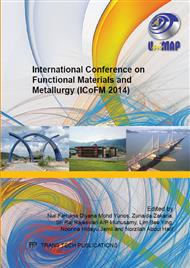p.3
p.9
p.15
p.20
p.25
p.31
p.39
p.45
Non-Isothermal Kinetic Modelling for Hydrogen Reduction of Ferric Oxide Using Matlab
Abstract:
Reduction of iron oxide by hydrogen is important in the production of direct reduced iron. This method of iron production is gaining increasing significance as an alternative route to the blast furnace technology with the many difficult issues facing the latter, the most important being the problem related to environmental. In order to reduce the emission of greenhouse gases CO2, particularly for iron making, the production of Direct Reduced Iron (DRI) using hydrogen as the reducing gas instead of carbon monoxide is being considered. Reduction of pure hematite by hydrogen was studied at the laboratory scale, varying the experimental conditions like temperature (700oC and 800oC) and porosity (20% and 40%). Then, a Kinetic Modelling was conducted using Matlab software based on independently measured physical and thermodynamic properties of the reaction system and experimentally measured properties of the reactant solid (Fe2O3), gas phase (H2) and reactant product (Fe). There is a gap that occurs between the predicted result and the experimental result although the model explicated the trend and the behaviour of the reduction rate of Ferric Oxide and indicated a good homogeneity to the experimental conditions used in this research.
Info:
Periodical:
Pages:
3-8
Citation:
Online since:
June 2015
Price:
Сopyright:
© 2015 Trans Tech Publications Ltd. All Rights Reserved
Share:
Citation:


